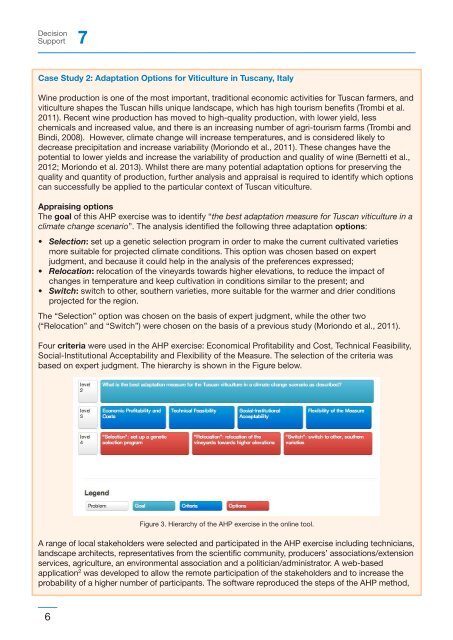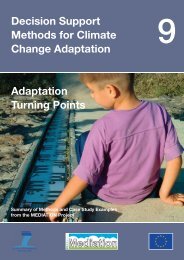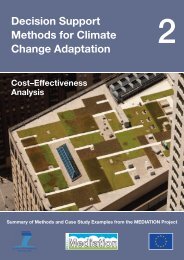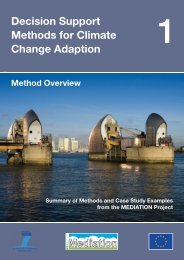Download all Technical Policy Briefing Notes in a single ... - Mediation
Download all Technical Policy Briefing Notes in a single ... - Mediation
Download all Technical Policy Briefing Notes in a single ... - Mediation
- No tags were found...
Create successful ePaper yourself
Turn your PDF publications into a flip-book with our unique Google optimized e-Paper software.
DecisionSupport 7Case Study 2: Adaptation Options for Viticulture <strong>in</strong> Tuscany, ItalyW<strong>in</strong>e production is one of the most important, traditional economic activities for Tuscan farmers, andviticulture shapes the Tuscan hills unique landscape, which has high tourism benefits (Trombi et al.2011). Recent w<strong>in</strong>e production has moved to high-quality production, with lower yield, lesschemicals and <strong>in</strong>creased value, and there is an <strong>in</strong>creas<strong>in</strong>g number of agri-tourism farms (Trombi andB<strong>in</strong>di, 2008). However, climate change will <strong>in</strong>crease temperatures, and is considered likely todecrease precipitation and <strong>in</strong>crease variability (Moriondo et al., 2011). These changes have thepotential to lower yields and <strong>in</strong>crease the variability of production and quality of w<strong>in</strong>e (Bernetti et al.,2012; Moriondo et al. 2013). Whilst there are many potential adaptation options for preserv<strong>in</strong>g thequality and quantity of production, further analysis and appraisal is required to identify which optionscan successfully be applied to the particular context of Tuscan viticulture.Apprais<strong>in</strong>g optionsThe goal of this AHP exercise was to identify “the best adaptation measure for Tuscan viticulture <strong>in</strong> aclimate change scenario”. The analysis identified the follow<strong>in</strong>g three adaptation options:• Selection: set up a genetic selection program <strong>in</strong> order to make the current cultivated varietiesmore suitable for projected climate conditions. This option was chosen based on expertjudgment, and because it could help <strong>in</strong> the analysis of the preferences expressed;• Relocation: relocation of the v<strong>in</strong>eyards towards higher elevations, to reduce the impact ofchanges <strong>in</strong> temperature and keep cultivation <strong>in</strong> conditions similar to the present; and• Switch: switch to other, southern varieties, more suitable for the warmer and drier conditionsprojected for the region.The “Selection” option was chosen on the basis of expert judgment, while the other two(“Relocation” and “Switch”) were chosen on the basis of a previous study (Moriondo et al., 2011).Four criteria were used <strong>in</strong> the AHP exercise: Economical Profitability and Cost, <strong>Technical</strong> Feasibility,Social-Institutional Acceptability and Flexibility of the Measure. The selection of the criteria wasbased on expert judgment. The hierarchy is shown <strong>in</strong> the Figure below.Figure 3. Hierarchy of the AHP exercise <strong>in</strong> the onl<strong>in</strong>e tool.A range of local stakeholders were selected and participated <strong>in</strong> the AHP exercise <strong>in</strong>clud<strong>in</strong>g technicians,landscape architects, representatives from the scientific community, producers’ associations/extensionservices, agriculture, an environmental association and a politician/adm<strong>in</strong>istrator. A web-basedapplication 2 was developed to <strong>all</strong>ow the remote participation of the stakeholders and to <strong>in</strong>crease theprobability of a higher number of participants. The software reproduced the steps of the AHP method,6





